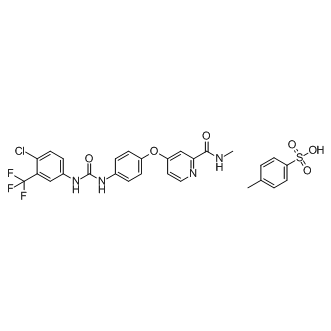| Description: |
Sorafenib tosylate is a potent multikinase inhibitor, with IC50s of 6 nM, 20 nM, and 22 nM for Raf-1, B-Raf, and VEGFR-3, respectively. |
| In Vivo: |
Sorafenib Tosylate (10, 30, 50 and 100 mg/kg, orally) treatment inhibits the tumor growth of 06-0606 and 10-0505 xenografts in a dose-dependent manner (P<0.01). The growth rate of 06-0606 and 10-0505 xenografts is also significantly reduced by Sorafenib. The weights of 06-0606 tumors in mice that are treated with Sorafenib 50 mg/kg and 100 mg/kg are approximately 13% and 5% of the controls, respectively. 50 mg dose of Sorafenib significantly inhibits tumor growth in mice with lines 5-1318, 26-1004 and 10-0505 (P<0.01). For 50 mg dose, the T/C ratio, where T and C are the median weight (mg) of Sorafenib- and vehicle-treated tumors at the end of the treatment, respectively, for 06-0606, 26-1004, 5-1318, and 10-0505 xenografts is 0.13, 0.10, 0.12 and 0.49, respectively[2]. The survival rate is 73.3 % in Diethyl nitrosamine (DENA) group and 83.3 % in Sorafenib group compared to 100 % in the normal control group. DENA group shows a significant increase in liver index (1.51-fold increase, p<0.05) compared to normal control group, while treatment with Sorafenib shows significant decrease (p<0.05) in liver index when compared to DENA group. The liver index in Sorafenib group significantly decreases to lower than its value in the normal control[3]. |
| In Vitro: |
Sorafenib Tosylate also inhibits BRAFwt (IC50=22 nM), BRAFV599E (IC50=38 nM), VEGFR-2 (IC50=90 nM), VEGFR-3 (IC50=20 nM), PDGFR-β (IC50=57 nM), c-KIT (IC50=68 nM), and Flt3 (IC50=58 nM) in biochemical assays[1]. Sorafenib-induced phosphorylation of c-Met, p70S6K and 4EBP1 is significantly reduced when 10-0505 cells are co-treated with anti-human anti-HGF antibody, suggesting that treatment with Sorafenib Tosylate leads to increased HGF secretion and activation of c-Met and mTOR targets[2]. |






















